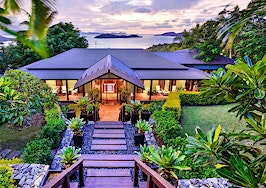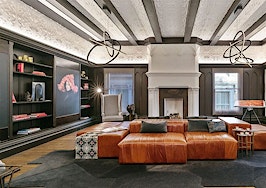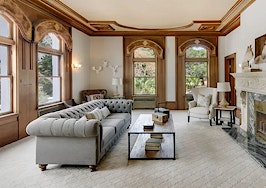Join the exceptional and become a Sotheby's International Realty agent.
Learn More
This has been a year of challenges and transformation for all industries, and the luxury real estate sector is no exception. For us, a critical change has been the urgent need for virtual assets on all key listings — and for many agents, myself included, this has been a change for the better.
It was inevitable that we become accustomed to providing virtual experiences of the highest quality for our buyers and sellers. Today, those virtual experiences are more sophisticated than ever, moving from interactive, multi-dimensional property views on the website to full immersion in a prospective home through a VR headset.
I’ve been monitoring and championing the implementation of more advanced VR across our brokerages both here in London and in markets abroad. Here are the trends I’m seeing with virtual — and my thoughts on how adopters and their clients can mutually benefit.
Virtual assets take the stage
It seems like just yesterday that video assets were enough for high-end brokerages looking to enhance their listings. Beautiful imagery, relaxing music, and captions or a voiceover would provide a summary of the property. In my practice, we were partial to featuring agents on camera, taking the viewer through the home.
That all changed abruptly during the period when markets were shut down this year. We couldn’t access our offices, sellers couldn’t show their homes, and buyers couldn’t visit properties. Worse still, travel was extremely limited, meaning London’s buyers from the Middle East and Asia were grounded. With self-isolation measures required at both the beginning and the end of an international flight, what would normally have been a trip of a few days soon became a five- or six-week commitment that most people were not willing to make.
For agents, this was a truly frustrating time. We’re a profession that can’t sit still, as we’re always out meeting and connecting with clients. Virtual offerings proved vital for our margins as much as for our own peace of mind. At first, we innovated in the ways that quickly became expected, such as providing virtual tours and open houses in real time — for example, my team was able to coordinate a showing, and eventually a sale, by bringing together a buyer in the Middle East, a seller in North London, and an agent outside of London in a five-person Zoom conference.
But we soon realized that we could take virtual touchpoints further — in fact, we had to. Our target luxury buyers in markets such as Hong Kong had become very accustomed to virtual experiences with their local high-end brokerages. We had to maintain our edge, and VR was the answer.
Turning virtual up a notch
The type of media our clients expect from us has evolved. Photos and floor plans have long been table stakes, as has video. Virtual is the next logical step. If you’re not already investing in VR for top tier clients to experience via a headset, it’s time to start thinking about custom, in-depth virtual content for your most high-end properties.
VR home tours offer clients full immersion in a property, and are easier to assemble than you might think:
- These VR experiences are most often created directly online, working from CGI, digital stills, and footage or photos taken on the plot or property if available.
- The VR goggles are then sent to buyers, enabling them to view the property at their leisure from the comfort of their own home, while still feeling like they’re onsite, physically navigating the space.
VR also gives buyers more options. A great example of this is our work with Smallbone, a prominent custom cabinetry firm based here in the U.K. We partner with their team to program immersive CGI mockups of multiple kitchen models into our VR experiences, so buyers can see different versions of the same space and immediately imagine themselves in their ideal setting. In doing so, we effectively preempt any negative impact of outdated kitchens. There’s no such thing as a dealbreaker when a home’s potential problems have been proactively anticipated and solved.
We put this anticipation mentality to the test recently at Hampton Hall, where there’s presently nothing to show to buyers except for an empty, spacious plot of land. The developer has plans for a truly exceptional property, so it was well worth our while to create a suite of preprogrammed VR visuals that let clients enjoy the unique opportunity to visit the currently unbuilt home. They are able to use a VR headset at the site, at our offices, or at their own home. As a result, we already have five interested, qualified buyers for a multi-million-dollar estate that doesn’t even exist yet.
Let signature listings shine
Before deploying this type of high-end VR, agents should bear in mind that neither the medium of virtual experiences nor the budget for developing and building them is worth it for every single property. Agents and sellers should think carefully about how much they want to show for certain listings; sometimes, it’s important not to predetermine a buyer’s expectations before they visit in person. But for signature listings and key clients, VR has huge benefits.
At the end of the day, it makes for a massive competitive advantage. This technology is still at a stage where many people haven’t tried it before — and once they do, word of its novelty and quality quickly spreads among their social circles and professional networks. It’s a great tool for brokerages looking to position themselves as market leaders, and it’s a game-changer in terms of what we can provide to sellers or show to buyers.
As a bonus, developing and compiling VR assets for new listings and construction projects keeps teams productive in uncertain times. It also enables us to connect with prospective clients anywhere in the world, regardless of travel restrictions. All we need to do is send them a headset and a preprogrammed tour.
Once a client commits to viewing a VR experience, they’re much more likely to come and see a property in person, and therefore more likely to make an offer. And in the case of the Hampton Hall property, they may even express interest in buying before it’s built. At a time when there are new challenges to presenting homes in person, VR delivers a powerful solution for clients and agents alike.

Guy Bradshaw
Guy Bradshaw has been working across Prime Central London for more than 16 years. With an in-depth knowledge of London’s key central locations, he has advised across Mayfair, Marylebone, Belgravia, Chelsea, Kensington, Notting Hill, and Holland Park throughout his career. He has an eye for advising for both investment and homeownership. He also has a global perspective on the property market, with key connections with colleagues in New York, Miami, Dubai, and Hong Kong.
About Sotheby’s International Realty
Sotheby’s International Realty was founded in 1976 as a real estate service for discerning clients of Sotheby’s auction house. Today, the company’s global footprint spans 990 offices located in 72 countries and territories worldwide, including 43 company-owned brokerage offices in key metropolitan and resort markets. In February 2004, Realogy entered into a long-term strategic alliance with Sotheby’s, the operator of the auction house. The agreement provided for the licensing of the Sotheby’s International Realty name and the development of a franchise system. The franchise system is comprised of an affiliate network, where each office is independently owned and operated. Sotheby’s International Realty supports its affiliates and agents with a host of operational, marketing, recruiting, educational and business development resources. Affiliates and agents also benefit from an association with the venerable Sotheby’s auction house, established in 1744. For more information, visit www.sothebysrealty.com.
The affiliate network is operated by Sotheby’s International Realty Affiliates LLC, and the company owned brokerages are operated by Sotheby’s International Realty, Inc. Both entities are subsidiaries of Realogy Holdings Corp. (NYSE: RLGY) a global leader in real estate franchising and provider of real estate brokerage, relocation and settlement services. Sotheby’s International Realty Affiliates LLC and Sotheby’s International Realty Inc., both fully support the principles of the Fair Housing Act and the Equal Opportunity Act.















